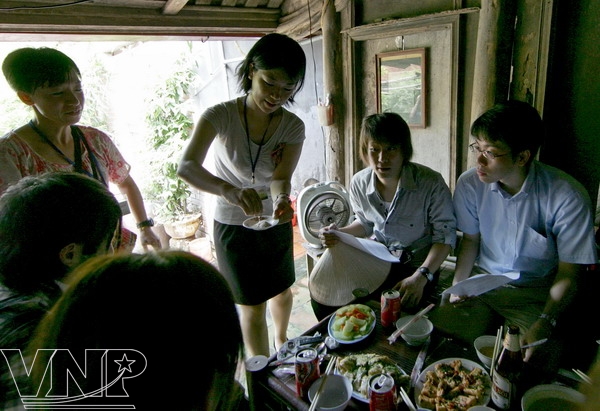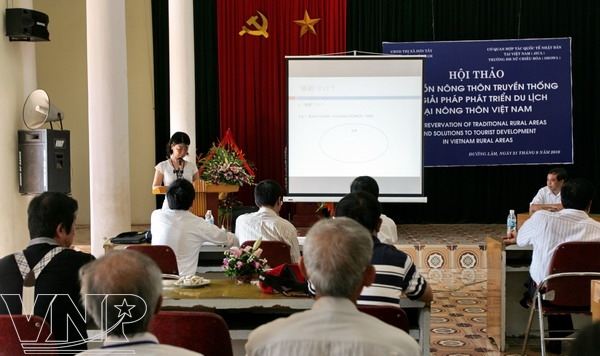In May, 2005 the ancient village of Duong Lam in Son Tay, which is 60km west of Hanoi, received a certificate of recognition as a national relic thanks to its cultural and historical value. It has an age-old history with many ancient houses and is considered a museum of laterite. With help from the Japanese International Cooperation Agency (JICA) many Japanese volunteers, including Aiko Inoue, a cultural heritage management specialist, have arrived in Duong Lam to help restore and preserve the village.
Since 2002 the programme supporting the development and preservation of traditional Vietnamese villages has been funded by JICA. Many Japanese experts from the Japanese Cultural Department, Nara National Institute of Cultural Assets and Chieu Hoa University have participated in restoring some of the works in the village, such as the village entrance, six ancient villages, etc. They have also devised projects to assist farmers in developing tourism and improving their living standards through exploring the potentials and strengths of the village.
With the guidance of Aiko Inoue, we visited the ancient house owned by Nguyen Van Hung, a descendant of the 12th generation of the Nguyen Van family in Duong Lam. The winding road from Mong Phu Communal House leading to the ancient house seems familiar to the Japanese expert. In 2008, the over 360-year-old house was evaluated and selected as the first work that needed to be restored and preserved. After nearly three months, the house not only remains intact but it has also become stronger.

Aiko Inoue, a cultural heritage management specialist, has been attached to Duong Lam Ancient Village for many years.

A path that leads to Duong Lam Ancient Village.

Aiko learns about the ancient well in the Ancient Village of Duong Lam.

Aiko talks with Phan Thi Hai, an elder in Duong Lam.

Aiko learns how to make Tuong (soya sauce) from Phan Thi Son in the village.

Aiko and some Japanese students have a meal with the family of Ha Nguyen Huyen in the village.

Aiko and her colleagues carefully research the culture and customs in Duong Lam.

Aiko presents her research on Duong Lam at a scientific workshop. |
Sitting in the airy space of the house, Aiko talked and introduced us to Yoriko, an architect and a cultural preservation specialist who works as a volunteer in the village. She said: “Aiko’s job is to measure and check structures and wood materials and give out solutions. My work is to survey the customs, cuisine and costumes of the local people.” Therefore, Aiko is very close to the local people and she has learned many things. She has learned how to make Tuong (soya sauce), a specialty of the village and Che lam (puffed rice candy). She also knows how to drink green tea, pick corn and dig potatoes. She talked a lot about her life here. “I feel this place is very intimate and friendly as if I were living in my homeland.”
Aiko graduated from the Cultural Heritage Preservation Specialist program at University College London and she has worked in Duong Lam Village since 2009. She said: “Many people have not yet recognized the value of the ancient village. They have primarily evaluated the architectural factors in terms of time while ignoring other important factors, such as customs, cuisine and traditional costumes. It is necessary to evaluate all these areas in order to recognize the entire value of the ancient village. We need to hand down measures to sustainably restore and preserve the cultural and historical values and maintain and improve the locals’ living standards by promoting tourism activities.”
Over the years, Aiko has thoroughly researched, surveyed and participated in many spiritual cultural activities. She realizes that Duong Lam Village has such basic values as nature, diverse scenery, good-natured and open-mined people, long-standing traditions, costumes, ancient houses, the landscape of ancient houses, and a very agricultural production method. If there are not enough of these factors, the village will lose its typical features. For this reason, besides researching and preserving the works, she and her colleagues have organized competitions and field-trips for students to learn about the ancient village.
At present, she and Prof. Tachibana in Showa University, Japan have helped to develop the cuisine service in the ancient houses and have made a map of the ancient village to assist tourists. She and other Japanese volunteers are also helping the villagers realize the value of the ancient village and to become aware of how to preserve the heritage and develop it as a unique tourism destination.
Story: Le Huu Tuan
Photos: Trong Chinh
Bài: Lê Hữu Tuấn - Ảnh: Trọng Chính